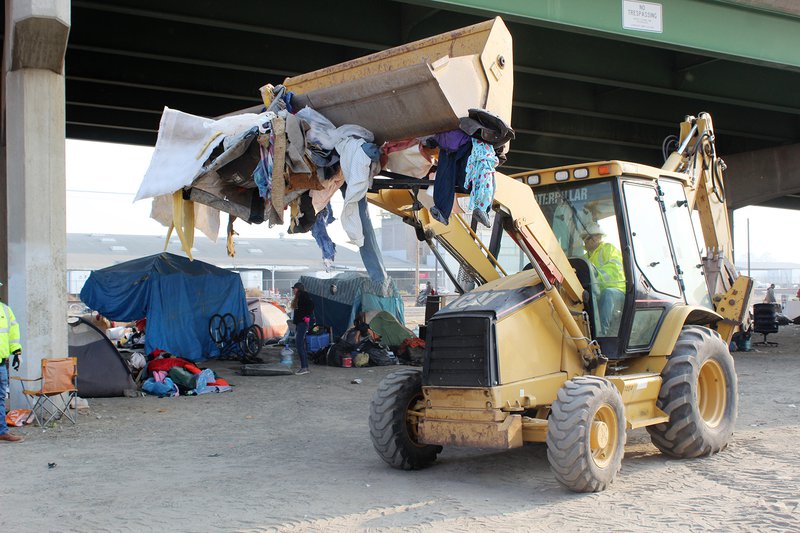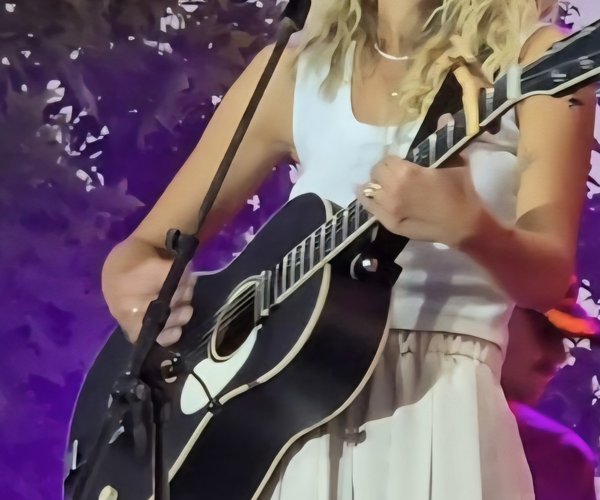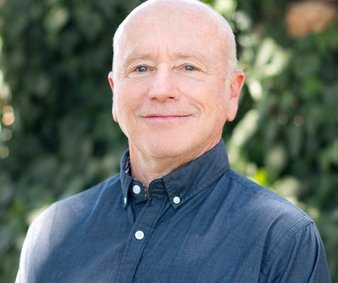The tent city that had been erected under the Golden State Boulevard overpass outside the Turlock city limits was dismantled by the Stanislaus County Public Works Department Thursday morning, leaving more than 50 homeless individuals looking for a place to sleep for the night and beyond.
Stanislaus County posted a notice at the encampment on Nov. 5 stating the tent city would have to be dismantled and removed by Nov. 15. The County stated the encampment was “a health and safety concern for both those occupying the right-of-way, the motoring public and for the road maintenance crews from the Department of Public Works.”

The question of where to go once the camp was dismantled was one pressing on the minds of many of the homeless individuals there and one that was not easily answered.
“We need a place to go,” said Samuel Borba, 54. Borba is a Turlock resident who said he had been homeless for about eight years and had been living at or near the camp for close to five months. “We need a place to stay where no one will mess with us and then we can live our lives a little bit. We are all very stressed.”

Michelle Pratt of Turlock said she had been living at the camp for about a month and over that time had seen 50 to 75 people move in and out of the area. She said they grouped together for safety, particularly because many of them had been hit with rocks of late. The people living at the camp included the elderly, some disabled individuals, one wheelchair-bound woman and one blind woman. Pratt said she had been speaking with county and city officials about a possible location for the group to use, but nothing had been settled.
“No one can come up with anything solid for us … and we have no where to go,” Pratt said. “I don’t expect it to be the Hilton. Just a piece of land — a space we can use.”
By Thursday mid-morning most of the homeless individuals at the camp had gathered up their possessions and were moving on to a new locale, including across the road for some. Workers with the county moved in with bulldozers and started removing any items left behind.
The dismantling of the camp comes at a time when many cities are having to reconsider bans on sleeping or camping in a public space because of a recent court ruling declaring such ordinances unconstitutional.
In September, the Court of Appeals Ninth Circuit ruled that it is cruel and unusual punishment and a violation of the Eighth Amendment of the Constitution to prosecute homeless individuals for sleeping on the streets when there is no shelter available.

The case arose out of a lawsuit filed in 2009 by six homeless individuals against the City of Boise in Idaho. Boise officials had passed an ordinance that banned people from sleeping or camping in buildings, on streets and other public places. The six individuals, who had been convicted of violating the ban, claimed in their lawsuit that the enforcement of the ban violated their constitutional rights.
The Court of Appeals agreed and said the ban amounted to criminalizing sleeping.
“As long as there is no option of sleeping indoors, the government cannot criminalize indigent, homeless people for sleeping outdoors, on public property, on the false premise they had a choice in the matter,” the judges wrote in their summary.
The ruling by the Court of Appeals gave pause to many cities who had similar ordinances as part of their municipal codes.
“Criminally punishing homeless people for sleeping on the street when they have nowhere else to go is inhumane, and we applaud the Court for holding that it is also unconstitutional,” said Maria Foscarinis, executive director at the National Law Center on Homelessness and Poverty, which co-filed the case in Boise.

“Cities with similar bans against sleeping in public should redirect resources to constructive solutions to homelessness, such as affordable housing and health services,” said Eric Tars, senior attorney at the National Law Center on Homelessness and Poverty.
Turlock’s municipal code states it is unlawful for any person to camp, occupy camp facilities or use camp paraphernalia in any park, on any street or at any public parking lot or public area, improved or unimproved. In September, the City stopped enforcing the ordinance in the wake of the court’s decision and it continues to be suspended. The City does have an ordinance which prohibits people from constructing or erecting “any building or structure of whatever kind, whether permanent or temporary in character” on any public lands, including tents in public parks.
On Thursday, several of the homeless individuals who had to move from the Golden State Boulevard encampment were relocating to the Sunnyview Park. Turlock Police officers were at the park and informed individuals they would not be allowed to erect tents in the park, said Turlock Police spokesman Sgt. Russ Holeman. Two people complied with the officers and took down their tents, but one woman did not and was issued a citation, Holeman said.
In an inter-office memo, Turlock Police Chief Nino Amirfar told his officers that they should continue to enforce the city’s other municipal codes and enforce the park closure hours on a case-by-case basis.
“In enforcing park closure hours, we will continue to be mindful of people using the parks for sleeping and who have no other practical shelter available to them,” Amirfar wrote. “Those person(s) will be allowed to sleep and they will be allowed to have blankets and or sleeping bags; however, the person(s) will not be allowed to erect any structure of any kind whatsoever in any city park.”
Stanislaus County has a similar code that prohibits camping in areas that are not designated by the County for camping, but like Turlock, has chosen to reduce the enforcement efforts because of the court ruling.
“We have not issued any citations in County parks for the last two months, but we continue to monitor these issues on a case-by-case basis,” said Stanislaus County Chief Executive Officer Jody Hayes.
Turlock has two homeless shelters. The Turlock Gospel Mission has beds for 59 women and children, with the requirement that guests check in by 4 p.m. and go through the intake process if it is their first visit. TGM Executive Director Christian Curby said the shelter has had an average of 40 guests at night, but expects to hit capacity now that the weather has turned colder.
The We Care shelter has beds for 49 men and has been at capacity routinely since the nights have gotten colder. Just on Tuesday night the shelter had 56 men seek a bed for the night and were forced to turn away seven because the beds were all filled.
“There are no requirements for men to stay at the shelter except that they have to be over 18 years of age,” said Executive Director Maris Sturtevant. “We accept those that are under the influence of drugs or alcohol as long as they want to be in a safe environment. Our goal is to provide a safe place for them to sleep and resources that empower them to become self-sufficient if they choose.”
Since posting the notice at the encampment, County officials, as well as the Turlock Gospel Mission, has been doing outreach at the site and trying to help people connect with available resources.
Outreach teams have attempted contact with individuals in Turlock multiple times over the last two weeks,” Hayes said. “Our efforts are focused on connecting individuals with all available resources in an attempt to shelter and house each person.”
Stanislaus County is planning to declare a shelter crisis for the region, which would open up millions in state funding through the Homeless Emergency Aid Program. H.E.A.P. is a $500 million block grant program designed to provide direct assistance to cities and counties to address the homelessness crisis throughout California. It was authorized by Senate Bill 850, which was signed into law by Gov. Jerry Brown in June 2018.
Stanislaus County is working with the Stanislaus Community System of Care to prepare the H.E.A.P. application and the crisis declaration. If Stanislaus County was chosen to receive some of the funds the money could be used to provide immediate emergency assistance to people experiencing homelessness or those at imminent risk of homelessness. Eligible uses include prevention activities; criminal justice diversion programs for homeless individuals with mental health needs; establishing or expanding services meeting the needs of homeless youth or youth at risk of homelessness; and emergency aid.
Reporter Angelina Martin contributed to this story.









